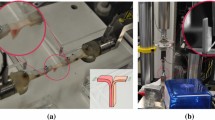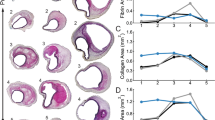Abstract
The left anterior descending (LAD) coronary artery is the most frequently involved vessel in coronary artery dissection, a cause of acute coronary syndrome or sudden cardiac death. The biomechanical mechanisms underlying arterial dissection are not well understood. This study investigated the dissection properties of LAD specimens harvested from explanted hearts at the time of cardiac transplantation, from patients with primary dilated cardiomyopathy (n = 12). Using a previously validated approach uniquely modified for these human LAD specimens, we quantified the local energy release rate, G, within different arterial layers during experimental dissection events (tissue tearing). Results show that the mean values of G during arterial dissection within the intima and within the media in human LADs are 20.7 ± 16.5 J/m2 and 10.3 ± 5.0 J/m2, respectively. The difference in dissection resistance between tearing events occurring within the intima and within the media is statistically significant. Our data fall in the same order of magnitude as most previous measurements of adhesive strength in other human arteries, with the differences in measured values of G within the layers most likely due to histologically observed differences in the structure and composition of arterial layers.





Similar content being viewed by others
Notes
Use of materials from human subjects was approved by the IRB at the Medical University of South Carolina, where the tissue harvest was carried out.
Estimation of G in this work assumes the artery has minimal deformation during delamination. This assumption can be readily modified to include the effect of the elasticity of the artery, e.g., use of an elastic foundation where the elastic properties of the aorta are determined separately.
References
Celik SK, Sagcan A, Altintig A, Yuksel M, Akin M, Kultursay H (2001) Primary spontaneous coronary artery dissections in atherosclerotic patients. Report of nine cases with review of the pertinent literature. Eur J Cardiothorac Surg 20(3):573–576
Schievink WI (2001) Spontaneous dissection of the carotid and vertebral arteries. N Engl J Med 344(12):898–906
Vrints CJ (2010) Spontaneous coronary artery dissection. Heart 96(10):801–808
Sommer G, Gasser TC, Regitnig P, Auer M, Holzapfel GA (2008) Dissection properties of the human aortic media: an experimental study. J Biomech Eng 130(2):021007
Pratt B, Curci J (2010) Arterial elastic fiber structure. Function and potential roles in acute aortic dissection. J Cardiovasc Surg (Torino) 51(5):647–656
Pasta S, Phillippi JA, Gleason TG, Vorp DA (2012) Effect of aneurysm on the mechanical dissection properties of the human ascending thoracic aorta. J Thorac Cardiovasc Surg 143(2):460–467
Tong J, Sommer G, Regitnig P, Holzapfel GA (2011) Dissection properties and mechanical strength of tissue components in human carotid bifurcations. Ann Biomed Eng 39(6):1703–1719
Wang Y, Johnson JA, Fulp A, Sutton MA, Lessner SM (2013) Adhesive strength of atherosclerotic plaque in a mouse model depends on local collagen content and elastin fragmentation. J Biomech 46:716–722
Wang Y, Ning J, Johnson JA, Sutton MA, Lessner SM (2011) Development of a quantitative mechanical test of atherosclerotic plaque stability. J Biomech 44(13):2439–2445
Southard JH, Belzer FO (1995) Organ preservation. Annu Rev Med 46:235–247
Wu B, Zhang Z, Lui W, Chen X, Wang Y, Chamberlain AA, Moreno-Rodriguez RA, Markwald RR, O’Rourke BP, Sharp DJ, Zheng D, Lenz J, Baldwin HS, Chang CP, Zhou B (2012) Endocardial cells form the coronary arteries by angiogenesis through myocardial-endocardial VEGF signaling. Cell 151(5):1083–1096
Nakashima Y, Wight TN, Sueishi K (2008) Early atherosclerosis in humans: role of diffuse intimal thickening and extracellular matrix proteoglycans. Cardiovasc Res 79(1):14–23
Acknowledgements
The authors would like to thank the staff of the Cardiothoracic Surgery Research unit at the Medical University of South Carolina for their assistance in specimen collection and transport. Research reported in this publication was supported by the National Institute of General Medical Sciences of the National Institutes of Health under grant number P20GM103444, and by the National Science Foundation under grant numbers NSF CMMI-1200358 and EPS-0903795. Dr. Francis Spinale is supported by the Research Service of the Department of Veterans Affairs. The study sponsors have played no role in the study design, analysis, or manuscript preparation.
Author information
Authors and Affiliations
Corresponding author
Rights and permissions
About this article
Cite this article
Wang, Y., Johnson, J.A., Spinale, F.G. et al. Quantitative Measurement of Dissection Resistance in Intimal and Medial Layers of Human Coronary Arteries. Exp Mech 54, 677–683 (2014). https://doi.org/10.1007/s11340-013-9836-0
Received:
Accepted:
Published:
Issue Date:
DOI: https://doi.org/10.1007/s11340-013-9836-0




